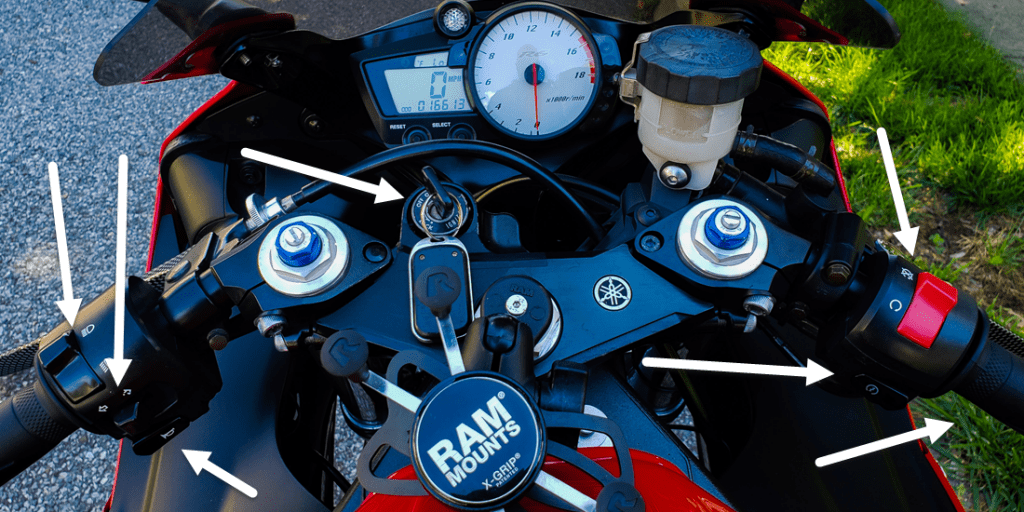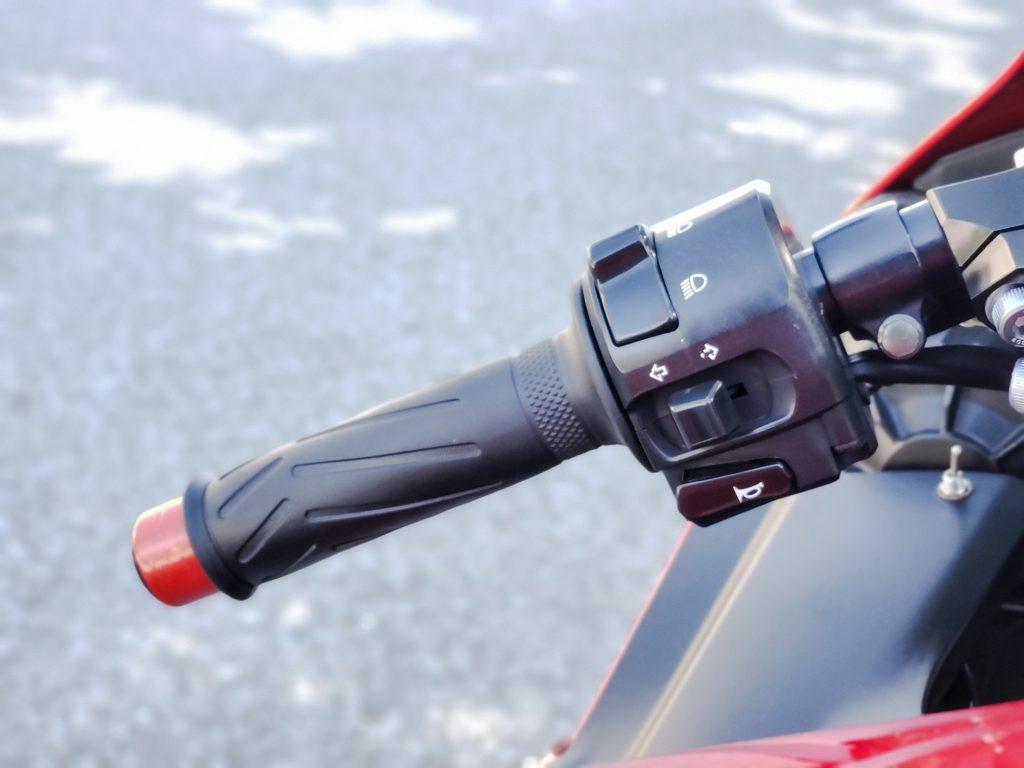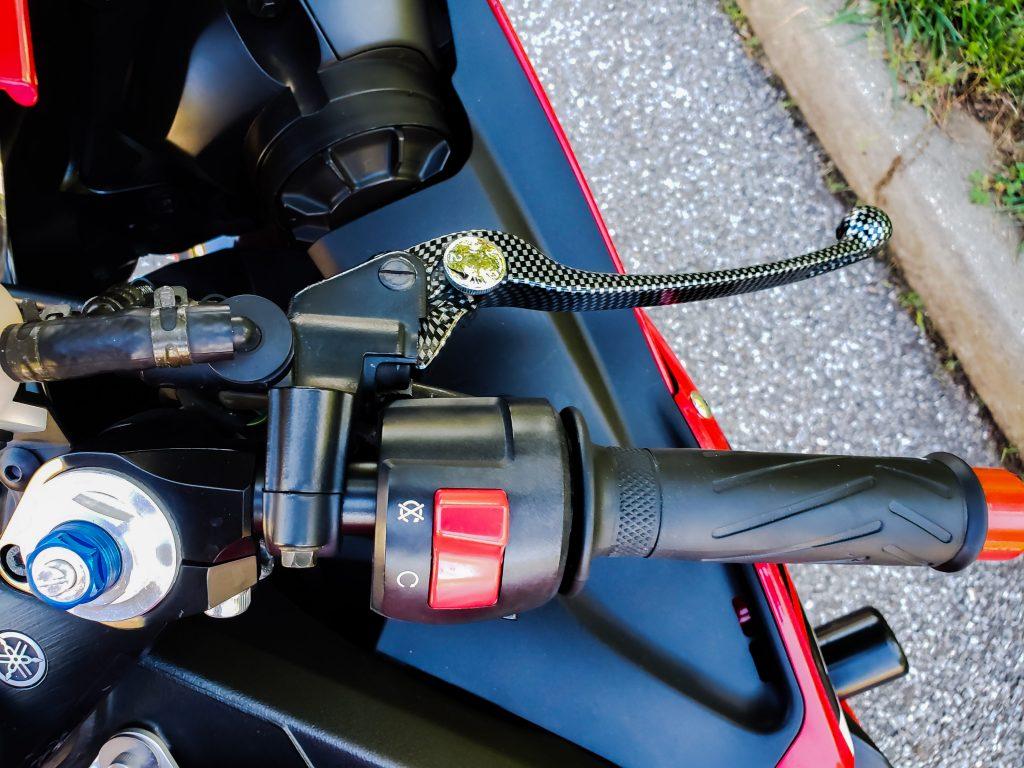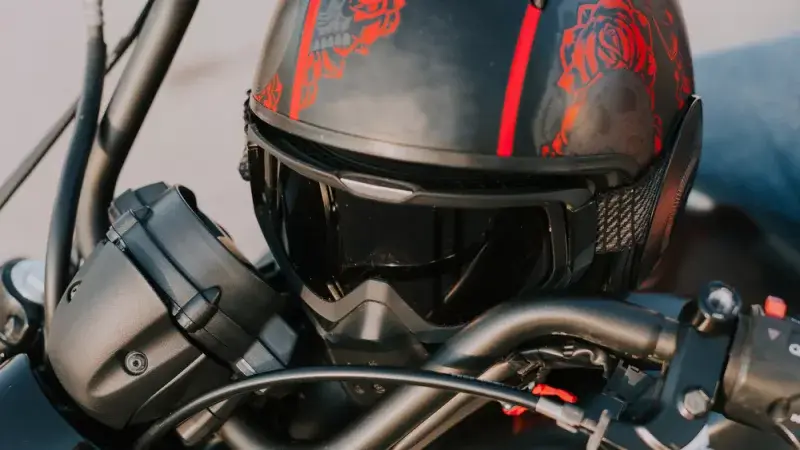The Sena 3S Bluetooth Headset can best be described as simple but good, a tiny, light headset that weighs about the same as a few coins. Not only is it light, but it is also very easy to use with just two buttons used to control the headset. The headset is available in two versions – the 3S-B with a boom mic or the 3S-W with a Lilliputian mic.
The Sena 3S Motorcycle Bluetooth Headset
The Sena 3S Bluetooth Headset is the next generation of the Nexx SXCOM, the first self-contained motorcycle system which was a joint venture of Sena and Nexx. The headset was introduced at the 2014 AIMExpo Show in Orlando, Florida. The 3S is smaller and lighter than the SX-COM, containing a pair of speakers and a microphone. It is self-contained and uses a Bluetooth stereo headset and intercom. For a cheap motorcycle Bluetooth headset, the 3S has everything you need and nothing you don’t.

Using the Sena 3S
Early motorcycle headsets were extremely difficult to use. Some were so complicated, you needed to tape instructions to the gas tank to remember what sequence of buttons to press. They had very limited range and it was sometimes impossible to talk to passengers through the headsets. Included with the headset is a four-page “Quick Start” booklet or you can download a .pdf form of the leaflet from Sena here. The headset powers up using a quick press of the + and – buttons. Even better, these two buttons control the entire system, whether you want to change the volume, use your phone or pair a GPS or MP3.




SMH3 Sound Quality
The speakers on the Sena 3S are a little bulky, but not any worse than other types of motorcycle headsets. The sound is good and can be heard easily over the sound of the bike. The microphones are sensitive so the mouthpiece does not need to be pressed to your mouth like other systems. In fact, if the mic is too close and the volume to high, the speakers are overwhelmed. Music quality is good as well and you can distinguish bass sounds easily. For a cheap motorcycle Bluetooth headset, the sound is outstanding, however.
Should I Choose the Boom or Wired Version?
Whether to choose the boom or wired version of the 3S depends on several factors. The boom version is designed for open-face helmets due to the location of the operating buttons. The + and – buttons are located along the top end of the microphone and, although you can reach under the face shield to press them, this can be difficult. If you are also wearing thick gloves or have a large face shield, accessing the buttons on the boom mic is not easy. However, the wired version doesn’t work as well in full-face helmets, especially if there is a large chin vent. In those cases, wind noise can affect microphone performance.
Sena 3S Features
- Two-buttons on the control pad on the mic or the external mount control all features.
- Bluetooth intercom up to 200 meters (220 yards) in open terrain.
- Bluetooth pairing for mobile phones (can connect dual mobile phones).
- Voice prompts.
- Bluetooth stereo headset with A2DP.
- Bluetooth music playback control by AVRCP: play, pause, track forward and track back.
- Integrated audio booster.
- Up to 8 hours talk time, 7 days stand-by time.
- Individual volume control for each audio source.
- Firmware upgradeable.
Two-year warranty.
In the Box
- Bluetooth Built-in Speaker-microphone Unit
- USB Power & Data Cable (Micro USB Type)
- Microphone Sponges
- Male Velcro Pads for Speakers
- Female Velcro Pads for Speakers
Sena 3S Specifications
- Talk time: 8 hours.
- Stand-by time: 7 days.
- Working distance (intercom): up to 200 meters (220 yards) in open terrain.
- Operating temperature: -10˚C ~ 55˚C (14°F ~ 131°F).
- Dimensions:
- Speaker: 39.9 mm x 39.9 mm x 11.3 mm ( 1.6 in x 1.6 in x 0.4 in )
- Boom microphone length: 180.0 mm ( 7.1 in )
- Weight:
Headset: 59 g ( 2.08 oz. )
Bluetooth:- Profile: Headset Profile, Hands-Free Profile (HFP), Advanced Audio Distribution Profile (A2DP), Audio Video. Remote Control Profile (AVRCP).
- Bluetooth 3.0
- Audio:
- Built-in SBC Codec
- Noise cancellation
- Wind noise reduction
- Wide volume control
- Sample rate: 48kHz (DAC)
- Battery:
- Charging time: 2.5 hours
- Type: Lithium polymer battery
Sena Downloads
As a cheap motorcycle Bluetooth headset, the Sena 3S appeals to several types of riders. It is perfect for those who want to try a Bluetooth intercom set or those who need an easy-to-use system that isn’t expensive. To learn more about the Sena 3S Motorcycle Bluetooth headset and other accessories for your bike, visit check out my YouTube channel.
You Might also like
-
Motorcycle Basics: Before You Start Riding
Before even hopping on a motorcycle, it’s a smart decision to ride about the mechanics of the machine and familiarize yourself with key concepts. Having an idea in your head is going to come in handy when you’re faced with common beginner problems or later on when you’re on the road.
That’s how you really get a handle on the motorcycle. Let’s get started.Motorcycle Basic Controls
Most motorcycles have the same controls; but you should always check the owner’s manual since the locations and shapes of some features will vary between makes and models.
motorcycle controls indicators and equipment Motorcycle basic parts:
Handlebars
Right side:
- Electric start button – usually yellow or white.
- Engine cut-off switch – above the electric start button. Usually red.
- Above the right throttle is the front brake lever.
Left side:
- Horn
- Indicators (blinkers)
- Choke
- Headlight dip switch (high beams/low)
- Clutch lever.
Between the handlebars, you find the ignition key. Ahead of the handlebars, you will also see the speedometer, odometer, and the tachometer.
motorcycle handlebar controls motorcycle throttle Older Styles and Off-Road Bikes
Here’s some special considerations if you are on an older model or have an off-road bike:
Fuel petcock – these are usually attached to the left near the carburetor. You can lean down to switch the gas tank when the fuel is getting low and you need to get to the gas station ASAP.Kick starter – off-road bikes have kick starters more commonly than street bikes. The kick starter works when you push down on the lever, turning the engine crank and causing the pistons to put pressure against the spark plug. Fuel ignites to start the engine.
What To Check Before Your Ride Every Time
Professional schools throughout the country use the acronym T-CLOCs to help you remember what you should check before heading on your bike. These checks should be done at least once a year, depending on how often you are riding your bike. If you ride every single day, you will have to use T-CLOCs much more often.
- T – Tires
- C – (Main) Controls
- L – Lights & other controls
- O – Oil & other fluids
- C – Chassis
- S – Stands
Tires
Check the air pressure and look at the condition of the tires. Are they worn down? Cracking? What is the condition of the spokes? Do you note any air leakage?
Next, look at the rims, bearings, seals, and casts. Does each brake work as it should? Does the bike fight you when turning or slowing down?
Controls
The main controls include the handlebars, cables, hoses, levels, pedals, and throttle. Make sure the condition of the hoses is good and that everything is properly lubricated. The bars should be straight, and the throttle should move without resistance. Ensure the hoses aren’t cut or leaking. Any bulges, chafing, cracks or fraying of control cables needs to be repaired.
Lights & Other Controls
This includes the battery, wiring, tail and signal lights, switches, blinkers, headlight, and reflectors. Is everything illuminating? Do the blinkers flash right? Is fraying or kinks in the wiring? Are the beams strong enough in the dark?
Oil & Other Fluids
Check the gaskets and seals for any leaks. Ensure the oil level is good, along with other fluid levels. Check for sediment in the coolant reservoir.
Chassis
The chassis is made up of the frame, suspension, chains, belts, and fasteners. Nothing should rattle. Nothing should be frayed, cracking, peeling, or chipping. Ensure that everything is tight and that there is tension in the belts and chains.
Stands
Check for cracks or bends in the stands. Springs should hold their position without looseness.
Basic Mechanics of a Motorcycle
Being that a motorcycle rides on two wheels, it is designed to lean to either side. Through balance and input from the ride, the motorcycle maintains an upright position. Many beginners are afraid that the bike is going to fall over if they lean too far, but that’s not the case. Through the forces of physics, such as friction, momentum, and gravity, it’s nearly impossible for a bike that’s going to straight to fall over.
Engine
Another reason the motorcycle stays upright is the force of the pistons in the engine. These pistons move up and down, creating a force that helps the moving bike maintain it’s upward position.
Tires
The tires of motorcycles are designed to be rounded, ensuring that as the bike rounds a corner, the same surface area of the tire remains on the ground.
Chassis
For the beginner, all you need to know about the chassis is how to sit properly. When positioned properly on the bike, your wrists, knees, and back will be comfortable. You should also be able to engage your core and thigh muscles when using your body to maneuver.
Clutch
Most bikes are manual transmission. The clutch keeps the bike moving but also controls the speed by using friction. Clutches are usually bathed in the same oiled the engine uses, so if you ride the clutch for a while, you won’t cause damage. However, some bikes are different, so refer to the owner’s manual.
Wrapping It Up
For the new rider, your focus should be memorizing where the controls are and what certain parts of the bike do. By learning the general location, you can drive much more safely (and not while staring at the handlebars).
Remember, the everything takes practice. In the same way you learned to ride a bicycle, you need some patience with riding a motorcycle. With that, you’re ready to begin!
Liked this article? Want more beginner’s tips? Subscribe to my YouTube channel to get notifications about the latest videos and never miss out.
-
Best Budget Motorcycle Helmet
Looking for a quality motorcycle helmet without breaking the bank? You’re not alone. Motorcycle helmets are a crucial safety investment, but navigating the options at a budget-friendly price point can be tricky. This article is here to help.
We understand the importance of balancing safety and affordability. That’s why we’ve conducted in-depth research to identify a helmet that offers both, exceeding what other budget options on the market can deliver.
Finding the Best Budget Motorcycle Helmet: Challenges
Skimping on a helmet is simply not an option. A motorcycle helmet is your first line of defense in a crash, and a well-made helmet can mean the difference between walking away and serious injury.
However, comparing features and quality within a limited budget can be a challenge. Many budget helmets sacrifice safety features or comfort for a lower price tag. Our goal is to help you find a helmet that prioritizes both without going over budget.
Stay tuned as we explore a helmet that defies expectations, offering excellent value for riders seeking a feature-rich, comfortable, and safe helmet around $250.
Key Takeaways
- Scorpion EXO Covert FX offers excellent value under $260, prioritizing safety, comfort, and features.
- DOT and ECE certified for meeting safety standards (depending on your region).
- Comfortable, removable, and washable liner for long rides.
- Anti-scratch, anti-fog visor for optimal clarity.
- Speaker pockets for easy communication system integration.
No products found.
Comparison Table Title: Top-Rated Budget Full-Face Motorcycle Helmets
Helmet Name Price (USD) Safety Certifications Liner Visor Features Additional Features Scorpion EXO Covert FX ~$260 DOT, ECE (depending on region) Removable, washable, moisture-wicking Anti-scratch, Anti-fog, Easy removal Speaker pockets Bell Qualifier DLX MIPS ~$280 DOT, ECE Removable, washable, anti-bacterial Anti-scratch, Anti-fog, Double shield system Pinlock-ready visor system, MIPS Brain Protection System HJC i10 ~$200 DOT, ECE Removable, washable Anti-scratch, Anti-fog Integrated sun shield No products found.
Notes:
- Prices are approximate and may vary depending on retailer and model year.
- This table is a starting point for your research. Be sure to read reviews and compare features before making a purchase.
Introducing the Scorpion EXO Covert FX
Coming in at around $250, the Scorpion EXO Covert FX stands out as a fantastic option for budget-minded riders seeking a feature-rich, comfortable, and safe full-face helmet. With its aggressive street fighter aesthetic, the Covert FX goes beyond just basic protection, offering a stylish design that complements your ride.
In-Depth Review of Scorpion EXO Covert FX
Safety Certifications:
Safety is paramount, and the Covert FX doesn’t disappoint. It meets the DOT and ECE safety standards (depending on your region), ensuring it has undergone rigorous testing to protect your head in a crash.
Comfort and Fit:
The Covert FX boasts a plush, removable and washable liner made with a moisture-wicking material. This translates to a comfortable ride, especially on longer journeys, and allows for easy cleaning after sweaty adventures. While the video mentioned potential sizing issues, the Covert FX comes in a wide range of sizes (XS-3XL) to ensure a proper fit. Finding the perfect size is crucial for both comfort and safety, so don’t hesitate to consult the manufacturer’s sizing guide or visit a motorcycle gear store to try one on before you buy.
Ventilation:
The Covert FX features a ventilation system with two intake vents on top and an exhaust vent at the rear. The reviewer in the video noted that airflow might not be the strongest, particularly for riders on naked bikes who experience more wind buffeting. However, for riders with fairings or those who don’t mind a bit more ventilation control, the system should provide adequate airflow.
Visor:
The Covert FX comes with an anti-scratch, anti-fog visor for optimal clarity and safety on the road. The video mentioned the visor is easy to remove for cleaning or replacement, a plus for keeping your vision clear.
Noise Levels:
The video reviewer mentioned some wind noise at higher speeds. While a quieter helmet is always preferable, this is a common trade-off for some budget helmets. If wind noise is a major concern for you, consider researching aftermarket wind tamer accessories that can be added to the helmet.
Additional Features:
The Covert FX includes integrated speaker pockets for easy installation of a communication system, perfect for staying connected with riding buddies or listening to music on your rides.
No products found.
Conclusion
The Scorpion EXO Covert FX is a remarkable helmet for budget-conscious riders who prioritize safety, comfort, and features without sacrificing style. It meets the highest safety standards (DOT and ECE), boasts a comfortable and washable liner, offers decent ventilation, and includes extras like a removable anti-scratch visor and speaker pockets – all at a price point under $250. As our research and the video review highlighted, the Covert FX delivers exceptional value for riders seeking a feature-rich, comfortable, and safe helmet.
If you’re looking for a helmet that excels in both safety and features without breaking the bank, the Scorpion EXO Covert FX is definitely worth considering. Several online retailers carry the Scorpion EXO Covert FX, and you can find more information and customer reviews with a quick web search.
No products found.
Additional Considerations
It’s important to note that the video review was based on a short-term assessment, and long-term durability remains to be seen. However, Scorpion is a reputable brand known for quality helmets, so you can be confident you’re getting a good product.
Finally, remember – a helmet’s most important quality is a proper fit. While we’ve provided information on the Covert FX’s size range, it’s crucial to try on a helmet before you buy to ensure a snug, comfortable fit. Visit your local motorcycle gear store and get sized by a professional to guarantee you get the best possible protection from your Scorpion EXO Covert FX.
Frequently Asked Questions About Budget Motorcycle Helmets
-
How to Ride a Motorcycle in the Rain
Be it a shower or deluge, rain can be your worst nightmare when on a motorcycle if you’re not properly prepared. During the spring and winter months, precipitation is unpredictable, and if you are in a rainy state, expect to get caught at least one shower while riding your bike. Rather than avoiding rainy days altogether, learn to ride your motorcycle in the rain.
Before The Ride
For maximum safety, inspect your bike to make sure it’s ready to tackle a ride in the rain.
• Fluids: Check your motorcycle to make sure there’s no brake fluid or oil leakage. While oil leaks aren’t very dangerous in dry conditions, when oil mixes with water, the road becomes a slick and dangerous course.
• Brakes: Make sure the brake pads have enough material left to help you with prompt stops in wet conditions.
• Tires: Check that your tires have enough tread to push water away and grip the road. You also want to ensure they have enough air pressure. Under or over-inflated tires react differently in water, but both are potentially dangerous.Weatherproof Gear
In order to keep you and your bike safe, you should have the correct riding gear and attire ready to go. You can choose between water-resistant and waterproof items. Water-resistant will shed water, but after a period of time, water will begin to permeate the material. Waterproof, on the other hand, will never allow for water to absorb into the material, unless you get completely submerged in water.
• Water-resistant or Waterproof Gear: Jackets and one piece suits should be zipped up tightly when riding in the rain to prevent water from seeping. Zippers should have a flap that covers the edges to protect the interstices. Cuffs on the jacket or coat need to be long enough to reach your gloves.
• Riding Boots and Gloves: More effective deterrents against complete saturation of your clothes. Both boots and gloves need to be tight enough to prevent water from dripping through. No one likes cold, wet socks.
• Helmets and Goggles: For the best protection, get a full-faced helmet. If you have a ½ or ¾ face helmet, get a pair of goggles. Pair the goggles with a waterproof balaclava that can shed water away from your face.
• Miscellaneous: If you have a saddlebag or storage unit, consider keeping a change of dry clothes with you. Also, keep plastic bags with you to keep valuables dry if you happen to get caught in a sudden rainstorm. Dry bags or waterproof backpacks can also help.Be Cautious Of Road Conditions
Wet roads are dangerous for motorcyclists and other vehicle drivers, regardless of how prepared you may be. Even when the roads appear clean, they could be slick from oil. Here are some things to consider when traveling by motorcycle in the rain:
Less Traction
The first hour of rainfall is the most dangerous, because oils absorbed into the asphalt rise to the surface. During this time, it’s best to pullover at a rest stop about wait for about an hour. Once the rain has washed the road of oil and debris, you can head out again. Remember that this also means an increased braking distance.
Less Visibility
Sometimes, the fog or mist is too dense, or the rain is falling so hard you or other drivers can’t see. You can make yourself more visible to the traffic around you by wearing high visibility clothing and reflective patches.
Hydroplaning Risk
Hydroplaning occurs when water prevents the tire from making contact with the road. Reduce the risk of hydroplaning by avoiding painted lines, manhole covers, iridescent patches on the road and puddles (oil), tar snakes, metal crossing, and other places with reduced traction.
Also, you should reduce your speed when approaching puddles you can’t maneuver around. Start slowing down, squeeze the clutch, then coast through the puddle. If you’re going too fast, it’s better to maintain that velocity rather than slowing down abruptly, as this will reduce friction could cause fishtailing.
Decrease the risk of hydroplaning further with all-weather tires.Nature’s Wrath
Stay aware of lightning, hail, ice, sleet, and other conditions that could transpire in a rainstorm. High winds can cause debris to fall into the road, and you might not see it due to decreased visibility. If it starts lightning, pull over.
Conclusion
Not every day is going to be perfect riding weather. Planning ahead and being prepared goes a long way when dealing with rainy conditions. Not only will you stay dry, but you will arrive at your destination safely.
Want more riding tips? Head over to my YouTube channel. Subscribe to receive notifications and never miss an update.














